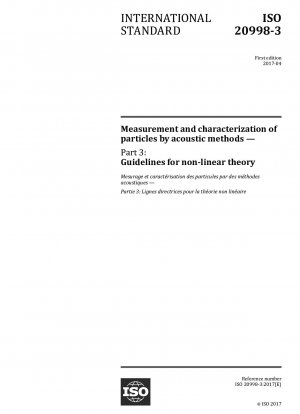ISO 20998-3:2017
Measurement and characterization of particles by acoustic methods - Part 3: Guidelines for non-linear theory
- Standard No.
- ISO 20998-3:2017
- Release Date
- 2017
- Published By
- International Organization for Standardization (ISO)
- Latest
- ISO 20998-3:2017
- Scope
- This document gives guidelines for ultrasonic attenuation spectroscopy methods for determining the size distributions of one or more material phases dispersed in a liquid at high concentrations, where the ultrasonic attenuation spectrum is not a linear function of the particle volume fraction. In this regime, particle-particle interactions are not negligible. This document is applicable to colloids, dispersions, slurries, and emulsions. The typical particle size for such analysis ranges from 10 nm to 3 mm, although particles outside this range have also been successfully measured. Measurements can be made for concentrations of the dispersed phase ranging from about 5 % by volume to over 50 % by volume, depending on the density contrast between the continuous and the dispersed phases, the particle size, and the frequency range[9] [10]. These ultrasonic methods can be used to monitor dynamic changes in the size distribution, including agglomeration or flocculation.
ISO 20998-3:2017 Referenced Document
- ISO 14488:2007 Particulate materials - Sampling and sample splitting for the determination of particulate properties
- ISO 20998-1:2006 Measurement and characterization of particles by acoustic methods - Part 1: Concepts and procedures in ultrasonic attenuation spectroscopy
- ISO 20998-2:2013 Measurement and characterization of particles by acoustic methods.Part 2: Guidelines for linear theory
- ISO GUIDE 35:2006 Reference materials - General and statistical principles for certification
ISO 20998-3:2017 history
- 2017 ISO 20998-3:2017 Measurement and characterization of particles by acoustic methods - Part 3: Guidelines for non-linear theory
